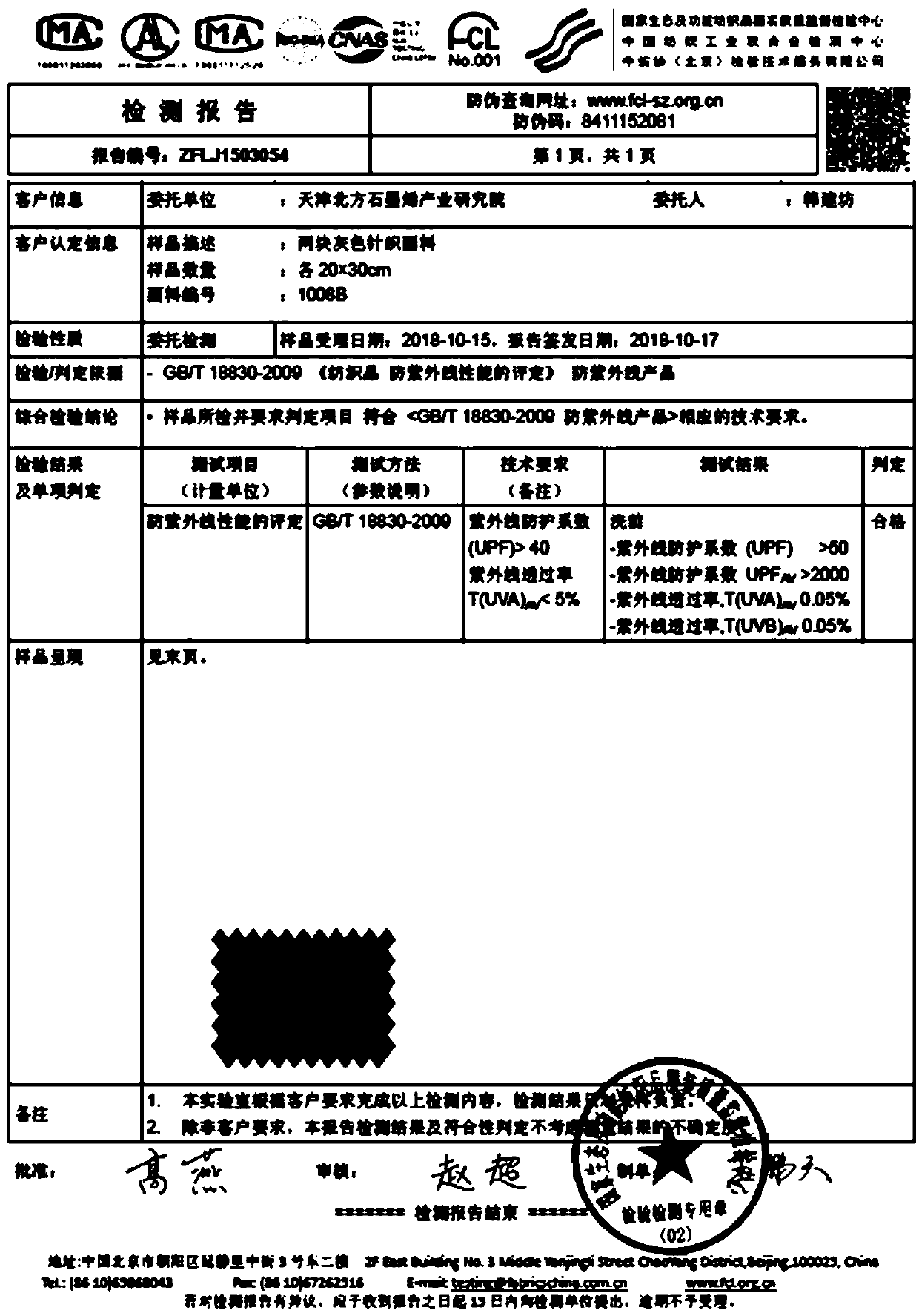Graphene-based antibacterial fabric preparation method
A kind of antibacterial fabric and graphene technology, applied in the field of textile manufacturing, can solve the problems that the uniformity of graphene dispersion cannot be guaranteed, the bonding force between graphene and fabric is weak, and the washing fastness can not meet the requirements, so as to achieve excellent antibacterial High effect, low cost, good washing fastness
- Summary
- Abstract
- Description
- Claims
- Application Information
AI Technical Summary
Problems solved by technology
Method used
Image
Examples
Embodiment 1
[0041] A method for preparing antibacterial fabrics based on graphene includes four procedures of fabric pretreatment, dye solution preparation, high-temperature dyeing, and drying and baking. The specific process is:
[0042] Fabric pretreatment: The treatment solution contains 1wt% sodium hydroxide, 0.1wt% JFC, and the bath ratio is 1:20. The treatment procedure is to add polyester fabric to the treatment solution at 35°C and raise the temperature to 85°C. Keep it warm for 1 hour, soak in 60℃ water for 10 minutes, wash once with 50℃ water, and wash with 30℃ water until the surface of the fabric is neutral.
[0043] Dye preparation: dilute the graphene oxide slurry with water, add sodium acetate-acetic acid buffer and BB emulsion (wherein, the mass ratio of benzyl benzoate and castor oil polyoxyethylene ether is 1:4), stir and mix thoroughly A dye solution with a graphene oxide content of 0.05 g / L, a buffer content of 0.20 g / L, and a BB emulsion content of 0.30 g / L was obtained, ...
Embodiment 2
[0047] A method for preparing antibacterial fabrics based on graphene includes four procedures of fabric pretreatment, dye solution preparation, high-temperature dyeing, and drying and baking. The specific process is:
[0048] Fabric pretreatment: The treatment solution contains 2wt% sodium hydroxide and 0.5wt% JFC, and the bath ratio is 1:20. The treatment procedure is to add polyester fabric to the treatment solution at 35°C and heat it to 85°C. Keep it warm for 1 hour, soak in 60℃ water for 10 minutes, wash once with 50℃ water, and wash with 30℃ water until the surface of the fabric is neutral.
[0049] Dye preparation: add sodium acetate-acetic acid buffer and BB emulsion (wherein, the mass ratio of benzyl benzoate and castor oil polyoxyethylene ether is 2:3), stir and mix well to obtain a graphene oxide content of 0.10g / L. A dye solution with a buffer content of 0.30g / L and a BB emulsion content of 0.40g / L has a pH of 4.2.
[0050] High-temperature dyeing: The polyester fabri...
Embodiment 3
[0053] A method for preparing antibacterial fabrics based on graphene includes four procedures of fabric pretreatment, dye solution preparation, high-temperature dyeing, and drying and baking. The specific process is:
[0054] Fabric pretreatment: the treatment solution contains 1wt% sodium hydroxide, 3wt% JFC, and the bath ratio is 1:20. The treatment procedure is to add polyester fabric to the 35℃ treatment solution, heat up to 85℃, and keep warm For 1 hour, soak in 60℃ water for 10 minutes, wash once with 50℃ water, and wash with 30℃ water until the surface of the fabric is neutral.
[0055] Dye preparation: dilute the graphene oxide slurry with water, add sodium acetate-acetic acid buffer and BB emulsion (among which, the mass ratio of benzyl benzoate and castor oil polyoxyethylene ether is 4:1), stir and mix thoroughly A dye solution with a graphene oxide content of 0.15 g / L, a buffer content of 0.40 g / L, and a BB emulsion content of 0.50 g / L was obtained, and the pH of the d...
PUM
 Login to View More
Login to View More Abstract
Description
Claims
Application Information
 Login to View More
Login to View More - R&D
- Intellectual Property
- Life Sciences
- Materials
- Tech Scout
- Unparalleled Data Quality
- Higher Quality Content
- 60% Fewer Hallucinations
Browse by: Latest US Patents, China's latest patents, Technical Efficacy Thesaurus, Application Domain, Technology Topic, Popular Technical Reports.
© 2025 PatSnap. All rights reserved.Legal|Privacy policy|Modern Slavery Act Transparency Statement|Sitemap|About US| Contact US: help@patsnap.com



